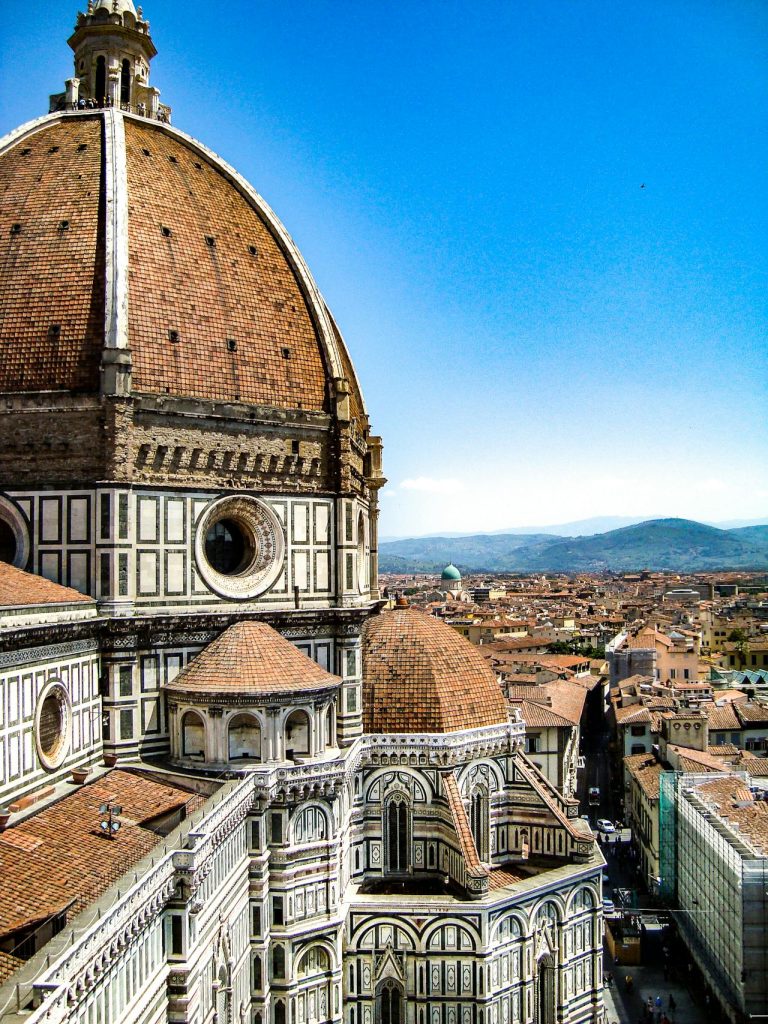Table of Contents
Filippo Brunelleschi, an architect and engineer of the Italian Renaissance, is renowned for revolutionizing architectural aesthetics and techniques. His innovations, particularly in the use of linear perspective and architectural design, laid the foundation for Renaissance architecture and influenced European art for centuries. This essay delves into Brunelleschi’s mastery of perspective, his iconic projects like the dome of Florence’s Cathedral of Santa Maria del Fiore, and his lasting impact on architecture and art.

Photo by Pexels
1. Historical Context and Background
Born in Florence in 1377, Brunelleschi initially trained as a goldsmith, a discipline that introduced him to the technical precision that would later define his work as an architect. Living through a period of intense cultural and intellectual renewal, he was surrounded by the works of Giotto and Dante, and he benefited from Florence’s vibrant intellectual life, which celebrated the rediscovery of classical philosophy and aesthetics. This environment motivated Brunelleschi to explore ancient Roman architecture and mathematics, setting the stage for his eventual architectural breakthroughs.
2. Mastery of Perspective: A New Way of Seeing
One of Brunelleschi’s most groundbreaking contributions was his formalization of linear perspective, which allowed artists and architects to depict three-dimensional spaces on two-dimensional surfaces with unprecedented accuracy. Linear perspective changed art by providing a structured method for creating depth and realism, which became essential elements of Renaissance painting and sculpture.
Brunelleschi conducted a famous experiment using the Baptistery of San Giovanni in Florence to demonstrate the principles of perspective. He painted the Baptistery on a small wooden panel, accurately calculating the vanishing points to create a lifelike image of the building. This method provided a mathematical approach to perspective that helped standardize proportions in art, creating the illusion of depth in painting and improving architectural symmetry in design.
3. Architectural Innovations: The Dome of Santa Maria del Fiore
The crowning achievement of Brunelleschi’s career, both literally and figuratively, was his design for the dome of Florence’s Cathedral of Santa Maria del Fiore, known as the Duomo. At the time, it was the largest dome in the world, and no architect had solved the problem of constructing a dome that large without traditional wooden supports.
Using an innovative double-shell design, Brunelleschi constructed a dome with an inner and outer layer, which provided strength and stability while reducing weight. He devised a unique herringbone brick pattern to improve cohesion, and the dome’s construction relied on a new hoisting mechanism that Brunelleschi himself designed, underscoring his engineering ingenuity.
The dome’s success was a landmark achievement in architectural history. Not only did it complete the cathedral that had stood incomplete for decades, but it also established Florence as a leading center of architectural innovation. The dome became a visual symbol of Florence’s cultural and intellectual ascendancy, and its design influenced numerous later domes, including Michelangelo’s design for St. Peter’s Basilica in Rome.
4. Humanism and Proportion in Brunelleschi’s Architecture
Brunelleschi’s work embodies the Renaissance ideals of humanism and proportion. His structures emphasize harmony and balance, which he achieved through the careful application of mathematical principles. For instance, in his design for the Pazzi Chapel, Brunelleschi employed classical Roman elements, such as Corinthian columns, and used proportion to create a sense of order and serenity.
The design of the chapel is based on modular planning, meaning that each part of the building is proportionally related to every other part. This symmetry represents the Renaissance belief in a universe governed by rational laws, echoing the humanist emphasis on the power of reason and the study of classical antiquity.
5. Influence on Renaissance Architecture and Beyond
Brunelleschi’s contributions extended beyond his buildings; he also reshaped the intellectual landscape of Renaissance architecture. His work inspired contemporaries like Leon Battista Alberti, who later formalized architectural principles in treatises that disseminated Brunelleschi’s ideas across Europe. The use of perspective and proportional systems in Brunelleschi’s buildings became standard practices in Renaissance architecture, influencing the design of palaces, churches, and civic structures throughout Italy and beyond.
Furthermore, Brunelleschi’s interdisciplinary approach—combining architecture, engineering, and art—helped solidify the Renaissance ideal of the “universal man,” who was skilled in multiple fields. His work laid the groundwork for subsequent architects, like Andrea Palladio, who continued developing proportioned, symmetrical buildings inspired by classical ideals.
6. Conclusion: Brunelleschi’s Legacy
Filippo Brunelleschi’s impact on Renaissance art and architecture is both profound and enduring. By reintroducing perspective to visual representation and solving complex engineering problems with innovative designs, he redefined architectural possibilities. His work harmonized mathematical precision with aesthetic beauty, exemplifying the Renaissance ideals of reason, proportion, and humanist philosophy. The dome of Florence’s cathedral, among other projects, stands as a testament to his genius and continues to inspire architects, artists, and engineers worldwide.
In essence, Brunelleschi’s art represents the convergence of science and beauty, a foundational principle of the Renaissance, and his work remains a cornerstone of architectural achievement. His legacy is visible not only in the structures he left behind but also in the techniques and principles that continue to shape the fields of architecture and engineering to this day.


No responses yet